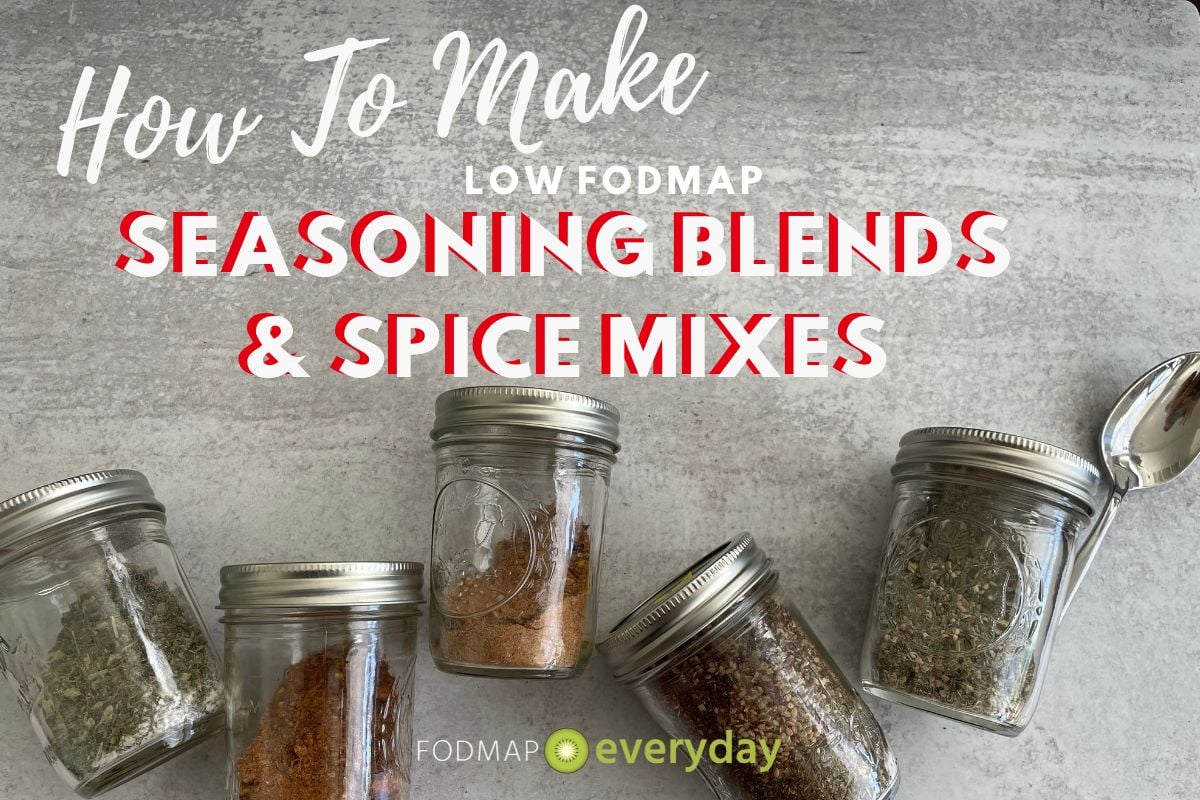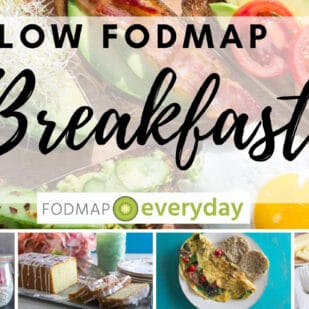What is Low FODMAP? What is Not?
As a Monash University FODMAP trained RD, curator of several low FODMAP grocery lists and low FODMAP support group moderator, I am often asked about natural flavors, artificial flavors, spices and flavorings (flavourings) that are commonplace on food labels.This article, How To Decipher Natural Flavors & Spices on Food Labels for the Low FODMAP Diet, will hopefully shed light on this confusing, and sometimes debatable subject.

- What is Low FODMAP? What is Not?
- A Global View
- USDA & the FDA
- The Australian Food Label
- The United Kingdom & European Food Label
- The Canadian Food Label
- Take Home Notes Regarding the Term “Spices”
- Take Home Points Regarding the Term "Natural Flavors, Flavors, Flavoring & Flavouring
- What About Artificial Flavors?
- The Takeaway
A Global View

I have included an international perspective since food label regulations vary from country to country. The following FODMAP trained dietitians helped contribute to this article and reviewed my interpretation of the international food labels to ensure they were accurately represented:
- Joanna Baker APD/AN/RN at Everyday Nutrition in Australia.
- Audrey Inouye, BSc, BaSc, RD at IBS Nutrition in Canada. (Some updates to Canadian labeling added January 2024)
- Diana Reid MPH, RD The Global Dietitian in Europe.
USDA & the FDA

Let’s first review the two governing agencies of the United States (US) Food Label – the FDA and the USDA.
The USDA regulates meat, poultry and eggs, which also includes products that contain 2% or more of a cooked meat or 3% or more of a raw meat. The FDA oversees all other food products.
Fun Fact: Once the egg is broken out of the shell it falls under the FDA, therefore cake mixes, cookies, and egg whites all fall under the FDA.
Let’s Discuss Natural Flavors/Flavoring/Flavouring
The USDA guidelines per the Code of Federal Regulations Title 9. 317.2 state that whole, broken, or ground garlic, celery, and onion must be declared on the food label and cannot be hidden under the word “spices”.
However, garlic powder, onion powder, and celery powder can be hidden under the term “natural flavors”, “natural flavorings”, and “flavoring” on the food label.
Note: I am not concerned with celery powder from a FODMAP perspective since it is unlikely that this equals more than ¼ (10 g) of a celery stalk.
Based on the FDA guidelines CFR – Code of Federal Regulations Title 21, the term natural flavor or natural flavoring means the essential oil, oleoresin, essence or extractive, protein hydrolysate, distillate, or any product of roasting, heating or enzymolysis, which contains the flavoring constituents derived from a spice, fruit or fruit juice, vegetable or vegetable juice, edible yeast, herb, bark, bud, root, leaf or similar plant material, meat, seafood, poultry, eggs, dairy products, or fermentation products thereof, whose significant function in food is flavoring rather than nutritional. Natural flavors, include the natural essence or extractives obtained from plants listed in subpart A of part 582 of this chapter, and the substances listed in 172.510 of this chapter.
By definition the term natural flavors is a bit ambiguous and may possibly include a high FODMAP fruit or juice, garlic powder, onion powder, inulin or chicory root, among other ingredients.
Based on multiple conversations with food manufacturers garlic and onion are often hidden under natural flavors in processed meats, broths, and other savory foods.
Let’s say the natural flavors do in fact contain a high FODMAP ingredient; it is impossible to determine how much of this ingredient was added and whether or not the amount is high enough to induce a symptom – especially since Monash also has very small Green Light serving size of many high FODMAP items (such as the garlic in Worcestershire sauce and ketchup).
Contacting Food Manufacturers About Flavorings

We like to be informed and will often contact a manufacturer to obtain more detailed information about ingredients on one of their food product’s labels. Let’s use a deli meat as an example that contains “natural flavors” to highlight some issues that we want to clarify.
The company that made the deli meat bought the flavoring from a third-party. There are flavoring manufacturers whose entire business is built on creating flavorings for the food industry. Typically, the natural flavor is their proprietary blend. They may or may not have shared what the components are to the deli meat company. Therefore, when you contact the deli meat company for information on the natural flavors on their product’s label, they might not even have the information you seek.
The USDA guidelines allow the flavoring company to NOT tell the deli meat company what is in the natural flavoring that they are purchasing, which means the info does not come down to you.
We communicated with the USDA in September 2023 and here is their statement. The bold italic is our emphasis:
“Regarding flavors being sold directly to food manufacturer or processor, our regulations state the following:
A flavor shall be labeled in the following way when shipped to a food manufacturer or processor (but not a consumer) for use in the manufacture of a fabricated food, unless it is a flavor for which a standard of identity has been promulgated, which case it shall be labeled as provided in the standard:
- If the flavor consists of one ingredient, it shall be declared by its common or usual name.
- If the flavor consists of two or more ingredients, the label either may declare each ingredient by its common or usual name or may state ‘All flavor ingredients contained in this product are approved for use in a regulation of the Food and Drug Administration.’ Any flavor ingredient not contained in one of these regulations, and any nonflavor ingredient, shall be separately listed on the label.
- In cases where the flavor contains a solely natural flavor(s), the flavor shall be so labeled, e.g., ‘strawberry flavor’, “banana flavor’, or ‘natural strawberry flavor’. In cases where the flavor contains both a natural flavor and an artificial flavor, the flavor shall be so labeled, e.g., ‘natural and artificial strawberry flavor’. In cases where the flavor contains a solely artificial flavor(s), the flavor shall be so labeled, e.g., ‘artificial strawberry flavor’,
21 CFR 101.22(g)”
So, what this means is that the consumer may never be able to determine what is within natural flavors on a food product they are buying. The good news is that flavorings are typically in such small amounts, that for the great majority of people, they will not be a digestive issue, even if they contain FODMAPs.
Let’s Talk About Inulin & Chicory Root
On a rare occasion I have heard that inulin and chicory root were present in the natural flavors (these ingredients yield a sweet taste) however, the quantity present is likely very small and unlikely to trigger an IBS symptom.
I frequently see inulin and chicory root added to yogurts, kefirs, herbal teas, gluten free breads, and cereal, however these are typically declared on the food label.
What Does “Less Than 2%” Mean on a Food Label?
As you look more closely at many US food labels you may notices some foods are present in quantities less than 2%. The US food labels list food ingredients in order from greatest to smallest amount. The ingredients listed towards the end of the food label are only present in minute amounts.
If they are less than 2%, this will be identified as such. Natural flavors found on the food label in quantities less than 2% are unlikely to trigger IBS symptom and do not need to be avoided.
A conservative approach would be to avoid a prepared food item if garlic or onion is listed anywhere on the label, even in quantities less than 2% during the Elimination Phase, since even this small dose can trigger an IBS symptom in some sensitive individuals. If you believe you are particularly sensitive, this would be the approach to take.
On the other hand, many individuals with IBS can tolerate high FODMAP foods that are present in such small amounts.
Work with your health professionals to determine your best approach.
Let’s Look at Garlic & Onion in Particular

We had direct communication with the FDA in September 2023 to get their most up-to-date statement in regard to onion and garlic. Here it is:
Ingredients, including onion and garlic, are required to be declared by the common or usual name on the label or labeling of a food in descending order of predominance by weight as part of the ingredient list. The descending order of predominance requirement does not apply to ingredients present in amounts of 2 percent or less by weight when a listing of these ingredients is placed at the end of the ingredient statement following an appropriate quantifying statement, such as “Contains 2% or less of onions, garlic.” If the onion or garlic are used as sub-ingredients (such as, an ingredient of another ingredient used into a finished food), the onion and garlic must be declared in a parenthetical listing after the common or usual name of the ingredient or by incorporating all of the sub-ingredients (including the onion and garlic) into the statement of ingredients in descending order of predominance in the finished food.
The Australian Food Label

This information provided was obtained from the document, “Standards Australia and New Zealand Ingredient Labelling of Foods User Guide to Standard 1.2.4 – Labelling of Ingredients”.
An Australian ingredient list contains percentages of the main ingredients, also called “characterizing ingredients”, which are listed in descending order based on their weight.
Garlic & Onion and Compound Ingredients
Garlic and onion are often declared on the food label, however this is not the case if they are used in a compound ingredient (an ingredient that is made up of two or more ingredients) that makes up less than 5% of the total weight of the food.
For example, if curry paste is contained in a food in a quantity less than 5% it can in fact contain onions, garlic, tomatoes, etc. and these ingredients do not need to be declared since they fall under a compound ingredient.
An exception to this is a food allergen – neither garlic or onion are considered as such. The allergens that must be listed include peanuts, tree nuts, milk, eggs, sesame seeds, fish and shellfish, soy, wheat and lupins.
Natural Flavourings & Spices
The term “Natural flavourings” or “flavour” can be used on a food label without having to declare the specific content or food additives present.
If “spices” or “natural flavouring” or “flavourings” are listed on the label in quantities less than 5% it is very unlikely that this trace amount of a high FODMAP ingredient, if actually present, would be enough to trigger an IBS symptom.
If “spices” or “natural flavouring” or “flavourings” are listed on the label in quantities greater than 5% read the label and avoid if high FODMAP ingredients are present. Compound ingredients that are 5% or more must declare what they are made of. However, note that there are lab tested and certified low FODMAP products on the market that contain garlic and/or onion or other high FODMAP ingredients (such as Sriracha, Worcestershire sauce, and Asian-style sweet chili sauce). The diet is very serving size dependent, and of course individual tolerance can vary.
Joanna Baker ADP/AN/RN from Everyday Nutrition states, “The only exception I tend to suggest avoiding is “vegetable powder” or “dehydrated vegetables”, which are almost certainly onion and garlic. I do recommend avoiding these completely in the Elimination Phase of the low FODMAP diet.”
The United Kingdom & European Food Label

Labeling requirements for the UK and Europe fall under the EU Food Information to Consumers Regulations and the Food Information Regulations.
In the European Union (EU) all food additives must be identified on the food label with the specific additive name or an E code/number such as E967 or xylitol. The E stands for Europe.
While there may be some food additives that trigger symptoms in sensitive individuals, polyols or sugar alcohols are confirmed high FODMAP ingredients that are to be avoided in the Elimination Phase. Here is a list of polyols and their corresponding E numbers to look out for when reading the food label.
- E 420i – Sorbitol
- E 420ii – Sorbitol syrup
- E 421i – Mannitol
- E 953 – Isomalt
- E 965i – Maltitol
- E 965ii – Maltitol syrup
- E 966 – Lactitol
- E 967 – Xylitol
- E 968 – Erythritol
(Note that while erythritol is indeed a polyol, Monash University has determined that both erythritol and glycerol do not typically trigger IBS symptoms as they are more easily absorbed in the small intestine than other polyols).
Allergens such as nuts, gluten, soy, and lactose must be declared on the food label.
However, it is not always necessary to avoid foods with lactose since a low FODMAP diet is not a lactose free diet. If the label contains 1 gram of lactose or less, it is suitable for the Elimination Phase. Also, if a lactase enzyme is present among the ingredients, the product is considered lactose free.
So What About Natural Flavors and Spices in the UK & EU?

Natural flavors are defined in the EU in regulation (EC) 1334/200: Flavouring preparations are flavourings other than defined chemical substances obtained from materials of vegetable, animal or microbiological origin, by appropriate physical, enzymatic or microbiological processes, either in the raw state of the material or after processing for human consumption. Natural flavouring substances correspond to substances that are naturally present and have been identified in nature.
If a specific ingredient or a category of ingredients such as flavorings makes up less than 2% of the total food weight it does not need to be declared on the food label, the QUID (Quantitative Ingredient Declaration) does not apply in these circumstances.
Basically, garlic, onion, or any other high FODMAP ingredient may be present in amounts less than 2% of total ingredients are NOT declared on the food label.
This trace of a high FODMAP food is very unlikely to trigger an IBS symptom, so need not to worry if you see the word spices or natural flavors in quantities less than 2%.
Glucose-Fructose in the EU
When following the low FODMAP diet, fructose is a sugar that we want to keep an eye on.
Glucose-Fructose syrup, also referred to as GFS, is a liquid sweetener often used in packaged and prepared foods and beverages. The glucose and fructose content can be present in varying compositions, with fructose ranging from 5 to 50%. If the fructose content exceeds 50%, the product will be listed as fructose-glucose syrup, or simply fructose-glucose.
If fructose is present in a larger percentage than glucose you will see the term “fructose-glucose” and this is a high FODMAP ingredient.
If the ingredient listed is glucose-fructose then the ingredient is considered low FODMAP.
The Canadian Food Label

Food labels are regulated by the Canadian Food Inspection Agency. In Canada the terms, “spices”, “seasoning” and “natural flavoring” are all exempt from having to declare their specific ingredients. Here are a few take away points.
The term “spices” refers to the aromatic part of the plant such as the seed, fruit or bark and is very unlikely to contain onion or garlic. You do not have to avoid foods containing spices.
When a product includes “seasonings,” companies are required to individually label the ingredients if they make up more than 2% of the total weight of the product. Therefore, if onion or garlic are included within “seasonings”, they will be less than 2% of the total weight. This amount is very small therefore unnecessary to avoid.
It is possible that garlic and/or onion powder may be included under the term “natural flavors.” However, natural flavors are often listed at the end of the ingredient list which means the amount is small and unnecessary to avoid.
When onion and garlic are listed as ingredients, the FODMAP content of the product may be variable depending on the amount of onion and/or garlic, and how the product was processed. For example, Sriracha, Worcestershire sauce, and sweet chili sauce contain garlic, but have lab-tested low FODMAP serving sizes.
If a product lists onion and/or garlic, then check the Monash app for a recommended serving size. If the product is not listed in the Monash app, it is difficult to assess the FODMAP content. If onion and/or garlic are a main ingredient, then the product should be avoided. If onion and/or garlic are listed at the end of the ingredient list, then a small serving may be acceptable.
Another ingredient to limit is glucose-fructose which can be high in fructose when consumed in larger amounts.
As always, eat to your tolerances.

Take Home Notes Regarding the Term “Spices”
- Per FDA and USDA guidelines, the word “spices” on the US Food Label cannot contain garlic or onion, however this is not true for other countries.
- If a food product in Australia, UK, or Europe (and outside of the USA) contains the word “spices” please contact the manufacturer to inquire if garlic or onion are in fact present, or avoid during Elimination.
- If a food product in Canada contains the word “spices” it is unlikely to contain garlic or onion and does not need to be avoided.

You May Want To Read: How To Make Low FODMAP Seasoning Blends and Spice Mixes
Take Home Points Regarding the Term “Natural Flavors, Flavors, Flavoring & Flavouring
First and foremost, ALWAYS listen to your dietitian or health care provider if they have made recommendations on how to treat “natural flavors”.
In general, it is not necessary to avoid natural flavors. If a high FODMAP ingredient is present within the natural flavors, it is unlikely to trigger IBS symptoms. This is not a guarantee. Your tolerances are unique.
It is important to remember that several foods containing garlic and onion have a Green Light low FODMAP serving sizes from Monash, as well as FODMAP Friendly. The diet is low FODMAP, not no FODMAP.

You May Want To Read: Low FODMAP Candy Ingredients
What About Artificial Flavors?
Now let’s quickly review artificial flavors. Here is how the FDA defines artificial flavoring:
“The term artificial flavor or artificial flavoring means any substance, the function of which is to impart flavor, which is not derived from a spice, fruit or fruit juice, vegetable or vegetable juice, edible yeast, herb, bark, bud, root, leaf or similar plant material, meat, fish, poultry, eggs, dairy products, or fermentation products thereof.” Basically, artificial flavors impart the flavor of a food, such as an apple without using a real apple. By definition, I consider artificial flavors low FODMAP, across the globe.
The Takeaway
I hope this article helps you better decipher the food label no matter when you live. Let us know if you have any questions in our comments section below!
FODMAP Everyday® opted to not include foods containing natural flavors (unless confirmed low FODMAP by direct communication with the manufacturer) in any amounts on our shopping lists to err on the side of caution and also in case your health care provider or RD encourages abstaining from these on the low FODMAP Elimination Phase.
As you may notice we had no trouble finding low FODMAP food products (without natural flavors) on our several low FODMAP Shopping Lists. We have literally vetted thousands of packaged foods for you. Take our Shopping Lists with you on your next shopping trip!
Editor’s Note: This article represents the experience and expertise of the author. At FODMAP Everyday® contributors are chosen for their unique voices, expertise and their credentials if they are sharing medically based information. Our goal is to educate you, the consumer, so that you can make informed decisions about your own health care.








Hello, Thank you for doing this research for the greater good!! I’ve tried and got lost many a time. You mention that ‘It is not necessary to avoid natural flavors in the UK and Europe if present in quantities less than 2%.’ which i’ve been looking out for on food labels.
I’m not sure if you mean that anywhere ‘natural flavours’ is listed this means the quantity is less than 2%? – it sometimes seems very high on the ingredients list which is making me confused!
Thanks for taking the time to read my question, if you know anything at all i’d love to hear it!
Thanks again for your informative article!
Vanessa’s answer: “Based on my clinical experience and speaking with other FODMAP dietitians across the globe many are not concerned with natural flavors when present in small quantities (ie. Less than 2-5%) and when present in larger quantities in non-savory foods. Rarely do we see natural flavors as an IBS trigger in these situations.
As a US based RD I am a little more concerned with natural flavors present in quantities greater than 2% in savory items such as meats and soups since this can translate to garlic and onion and may be present in quantities large enough to induce a response in some sensitive individuals.”
You could call manufacturers to ask if the flavorings are derived in any way from garlic or onion and you might get a straight answer. Any which way, if there is a product that you really want to be able to eat, the only way is to try. If you are stable, then Challenge yourself with it to see if you digest it well without triggering symptoms. After all, regardless of what a product contains, whether YOU can tolerate it is the most important thing and you cannot assess that without trying.
Thank you for publishing this article about natural flavors. I have two comments. I’ve never seen a percent notation on a product with natural flavors. This should be required. My second comment is that I see no mention of an IBS reaction in your article, when it comes to eating multiple foods that have natural flavors. So many foods have natural flavors. If you eat two or three of these every day or so, you are raising the percentage of natural flavors. What ate your comments on this? Thank you.
Susan, FODMAP Stacking is a topic unto itself and we have two articles that address it. Yes, in theory, every time we discuss FODMAPS, from any angle, stacking would be mentioned, but it is just considered part and parcel with the diet. This is why self-education is so important! You can read our stacking articles HERE and HERE.
Thank you for the quick reply. I have spent more than a year now, educating myself. It’s a very difficult diet to follow because there are so many fodmaps. Part of my problem is that I don’t think I should have to restrict my foods much. I believe more regulation on fodmaps added to foods is needed. Really appreciate your response and the link to the stacking articles.
So glad you took time to check out the article. The diet is very nuanced and complex, which is why it is recommended to be undertaken along with a trained RD. Their goal – and ours – is actually to help individuals eat as BROADLY as possible. It just isn’t always obvious how to get to that point. A “low FODMAP serving size” is the size that does not trigger symptoms for YOU. This might be different from what the apps say, which are what are determined in lab tests. You are not a lab! You might like this article on What Is A Low FODMAP Serving Size?